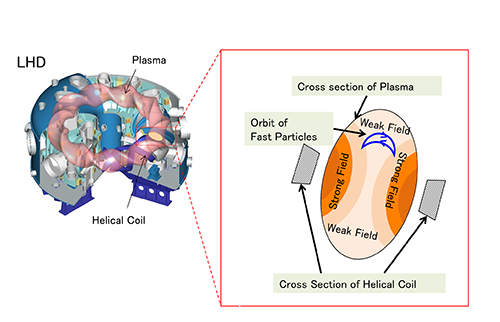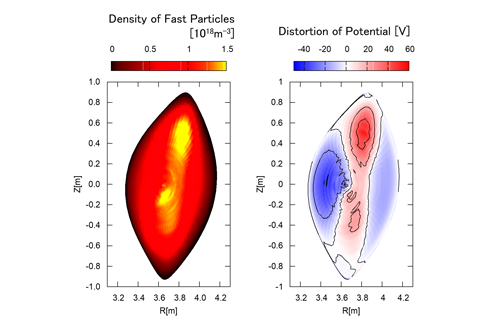HOME > Research Activities > Research Updates >
High-Precision Particle Simulation Research
Many people see lightning flashes in the hanging dark clouds and below the clouds. At the moment the lightning flashes, the electric currents are flowing in the lightning. The currents have the property of flowing from high potential to low potential, as water flows from high to low. For example, in a dry battery where the potential of the positive pole is higher than that of the negative pole, the functions of chemical materials included in the battery produce the difference in the height of the potential, which is also called "Voltage ." In the plasma, the differences in the height of the electric potential, in short, the electric potential differences are produced by mechanisms different from those in the clouds and the dry battery. Here, we introduce computer simulation research on the electric potential in the plasma.
In the Large Helical Device (LHD), we research the confinement of high temperature plasma with strong magnetic fields. The high temperature plasma in the LHD is created from hydrogen gas. In addition to the hydrogen ions and electrons, there are in the plasma metal ions, carbon ions, oxygen ions, and other ions. The ions other than the hydrogen ions are called the impurity ions. If too many impurity ions are stored in the plasma, the plasma temperature falls. Therefore, it is important to clarify how the impurity ions move in the plasma.
The electric potential difference in the plasma can significantly influence the movements of the impurity ions. The charged particles react to the electric potential difference more sensitively if their charges are larger. The charge of a hydrogen ion is one. However, the charges of impurity ions can be larger. For example, the charges of fuel ions can be greater than twenty. Therefore, the impurity ions can react even to a minute electric potential. We call the minute electric potential "the potential distortion."
The theory and simulation group at NIFS focuses on fast particles as the cause of the potential distortion and promotes the computer simulation research on the potential distortion. The fast particles discussed in this article are produced by the injection of fast hydrogen atoms for heating the plasma. The fast particles move under the influences of the magnetic fields and of collisions with electrons or ions, and they diffuse gradually in the plasma. As a result, the density distribution of the fast particles is formed. Because the fast particles have charges, it is expected that nonuniformity of the fast particle density induces nonuniformity of charges, and the electric potential is distorted. For calculating the potential distortion, it is necessary to track the movement of many fast particles and to calculate their density distribution. Using a developed simulation code to track such fast particles with high precision, we have succeeded in obtaining the detailed density distribution of the fast particles. We consider the fast particles that have been produced by the injection of hydrogen atoms in the direction perpendicular to the magnetic field. The fast particles tend to be trapped in the region where the magnetic field is weak. We have clarified that this tendency causes the potential distortion. Furthermore, we have found that this potential distortion increases the flow of the impurity ions to outside the plasma.
In the future, we will compare the simulation results with the LHD experimental results on the distributions of the fast particle density and of the electric potential in detail. We will then aim for more precise prediction of the impurity ion flow that can be strongly influenced by the electric potential in the plasma.

Fig. 1: A schematic diagram (left) of the LHD and its cross section (right). The fast particles tend to be trapped in the weak magnetic field region far from the coils.

Fig. 2:Distributions of fast particle density (left) and potential distortion (right) on the plasma cross sections. These are obtained by the computer simulations. "R" of the horizontal axis shows the distance from the center of a twisted doughnut-shaped plasma, and "Z" of the vertical axis shows the vertical positions from the plasma center.
